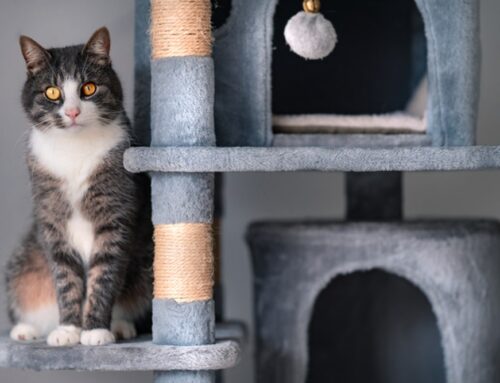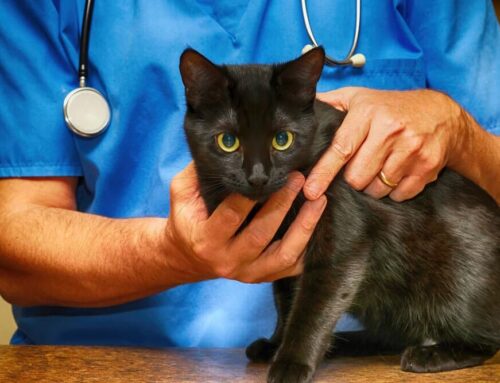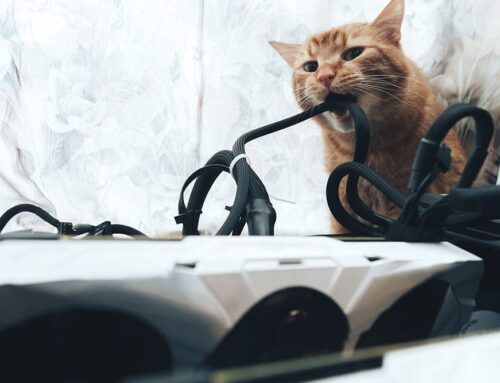Do you have plans for August 17? Of course you do! It’s National Black Cat Appreciation Day. Just Cats Clinic has a number of educational party favors to share with you. Take a break from wrapping your black kitty’s presents, and read some information about these special shadowy felines, their checkered past, and how to be part of their image makeover.
It’s not all scary—reverence for black cats
Black cat history actually begins in a happy time, with adoration and worship:
- Egypt — Egyptians worshiped a powerful black cat goddess, Bastet, and held cats in such high regard that their death entailed family mourning, feline mummification, and entombment with the family.
- Japan — Black cats have a long history of high regard as symbols of good luck, prosperity, and guardians against evil.
- Scotland — Scottish lore says a cat visiting your home means prosperity.
- England — The British view black cats as good fortune. Their approach signals good luck, while their cat leaving means a loss of luck.
What’s to fear?—black cats and their dark history

The color black is historically perceived with negativity and foreboding in many cultures, as a symbol of death, evil, and the unknown. Unfortunately, because of their naturally elusive, quiet nature, and steady gaze, when the Romans brought cats from Asia to Europe, their public perception took a bad turn.
- Black magic — During the medieval period, the mystery of black cats led to their presumed affiliation with witchcraft and witches.
- Symbol of evil — Pope Gregory IX pronounced black cats as a sign of the devil, leading to their hunting, torture, and near extinction in certain areas of Europe.
- Symbol of evil abroad — The stigma assigned to black cats followed them to America, where the Pilgrims regarded black cats as satanic, and punished or killed anyone caught with a black cat, for their contact with evil.
- Different era, same suspicion — In the 1880s, black cats were the symbol of anarchism, and later sabotaged during the first World War.
Many classic black cat and witchcraft superstitions are still believed in the United States today, showing that an association with Satan—including a fictitious one—is awfully hard to shake.
But you’re wrong—the sad impact of black cat beliefs
Popular misunderstanding of black cats caused by myth, superstition, religious, or cultural beliefs has resulted in increased violence and cruelty against black cats still today, typically centered around Halloween. This has led to higher numbers of black cats in shelters, and longer adoption wait times for black shelter cats and kittens.
How can superstitions more than 1,000 years old still impact black cats’ lives today? Perhaps because of black cat bias (BCB,) which is a phenomenon of negative perception, low adoption rates, and higher euthanasia rates in black cats. BCB has a lot of anecdotal data, but little statistical information for validation. Still, any level of bias, especially when our beloved black cats are forced to suffer, needs close examination. Reasons for these beliefs may include:

- The eyes have it — A black cat’s dark facial features and eyes may make people unsure of their emotional state.
- Symbolism, again — The color black may contribute to the misconception that black cats are aggressive, sneaky, or unpredictable.
- Superstitious is as superstitious does — One study showed that people who identify as superstitious are more likely to show black cat bias.
- Blame it on the genes — The high number of black cats and dogs in shelters is possibly because a disproportionate number of animals are born with the black color gene, rather than a reflection of being unwanted because of their color.
Wrong again—the truth about black cats
Our dear readers hopefully understand that black cats are incredible companions who are no different than any other cat, and, in truth, may be more special:
- Temperament — According to scientist and animal advocate Temple Grandin, darker-colored animals have the most stable and balanced temperaments, because of the protective effect of melanin on the midbrain.
- Disease — The genetic mutation for a black coat may provide disease resistance, and is being studied for potential contributions to Alzheimer’s disease and cancer.
- Times two —Black cats actually require two days of recognition, with a second on October 27, for National Black Cat Day.
- Fashionable — Black is always in vogue, so black cats always look good!
Out of the darkness—creating a bright future for black cats

Black cats are an example of the power of myth and superstition, but with advocacy and good marketing of events like National Black Cat Appreciation Day, cat lovers can help push negative history aside, and help people see the true spirit and beauty of the black cat. Easy ways to champion positive recognition of black cats include:
- Black tie optional — Support your local shelter’s black cat fund-raisers and adoption events, or volunteer to start one.
- Picture perfect — Learn to properly photograph black animals, and then offer to take pictures for your area shelters. See The Black Dogs Project, written by Fred Levy, and published by Race Point Publishing.
- Let your black cat take over your social media — Post pictures, funny quotes, and messages about black cats’ wonderful qualities—and the lore of good luck!
Although history hasn’t always been kind to black cats, thousands of years of civilization has always known one thing—black cats are truly magical, but in a good way.
Do you have questions about your cat, or need to schedule an appointment? Don’t forget August 17! Contact the team at Just Cats Clinic if you want ideas for celebrating National Black Cat Appreciation Day, and to positively promote black cats every day.













